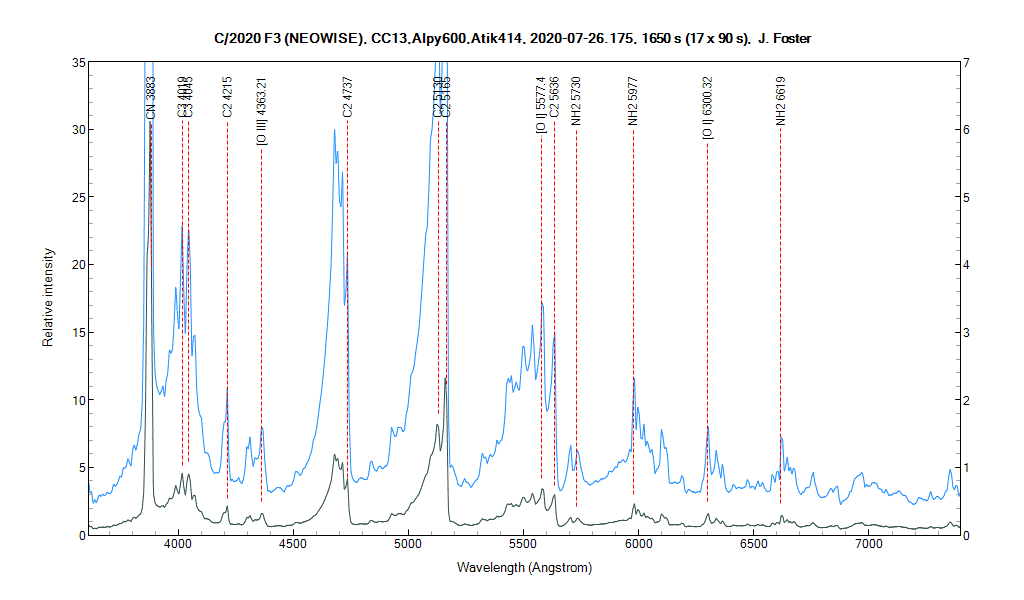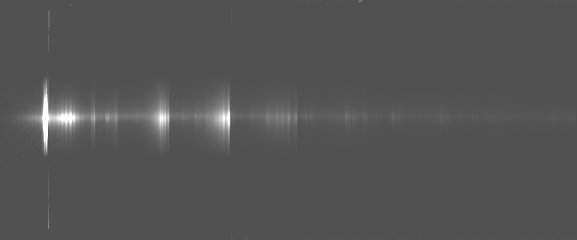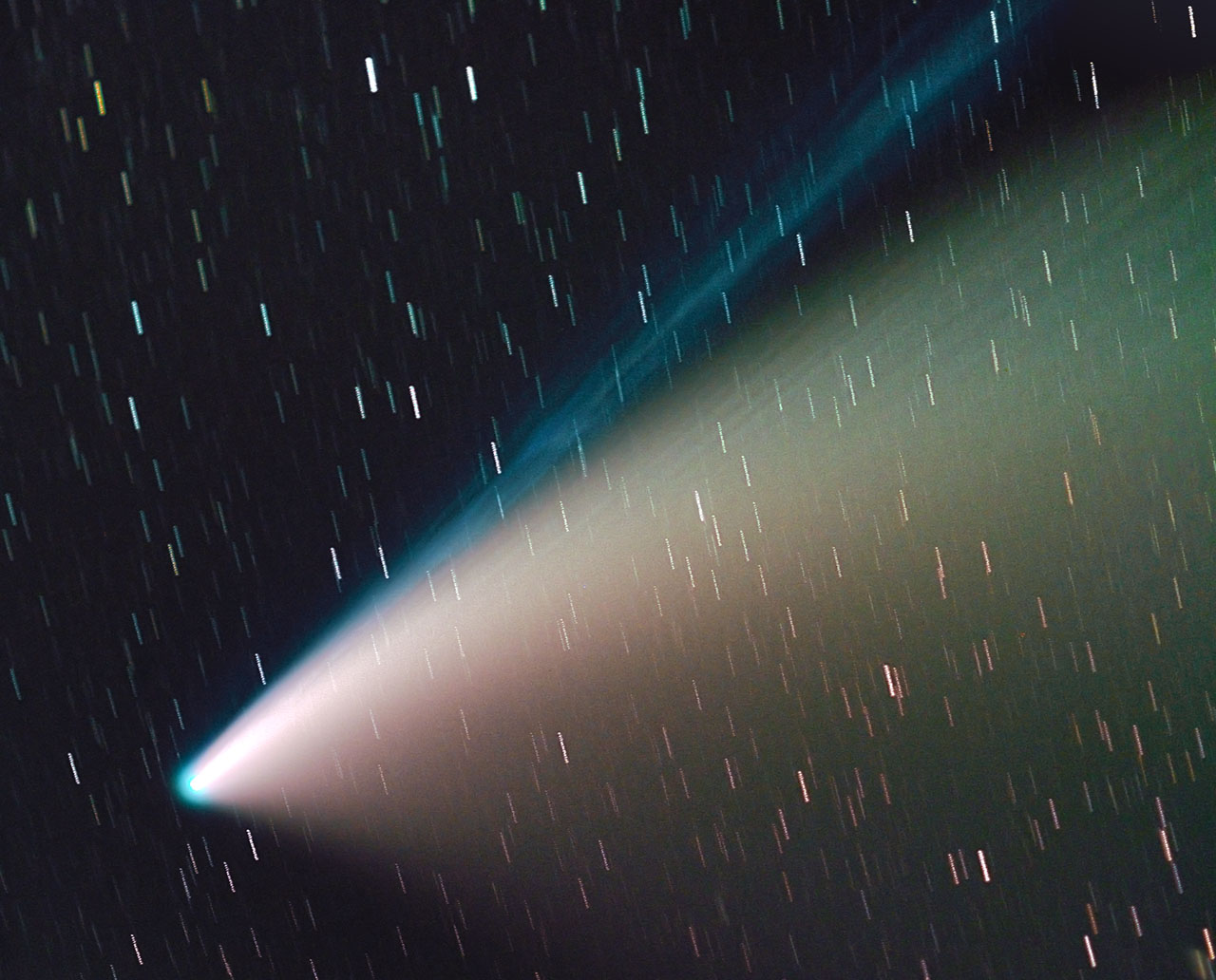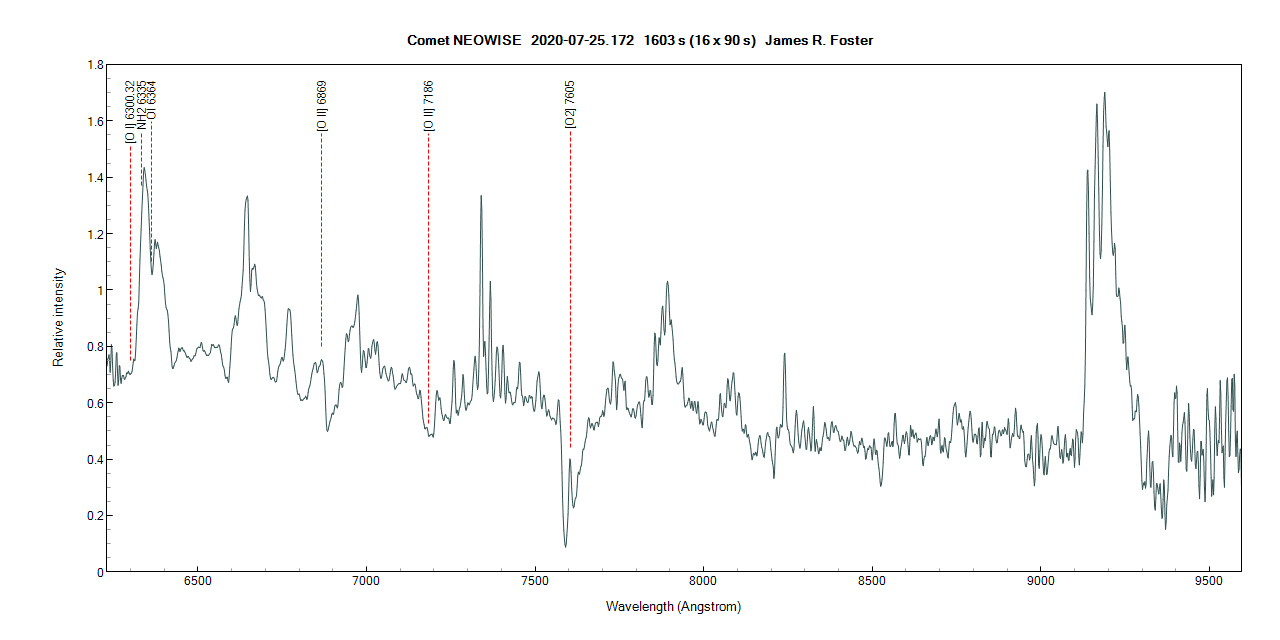C2020 F3 (NEOWISE) spectrum
-
Daniel Dejean
- Posts: 127
- Joined: Sun Sep 18, 2016 7:20 am
Re: C2020 F3 (NEOWISE) spectrum
Bonsoir Fran,
Cette comète inattendue est effectivement une belle opportunité pour un retour aux observations en spectrographie. C'est ma première expérience dans ce domaine et c'est vraiment très impressionnant de voir un tel objet dans la caméra guide. Une rare occasion à ne pas manquer ! L'inconvénient bien sûr de cette large extension sur la plus grande partie de la fente est de rendre plus délicate la soustraction du fond du ciel. Ton image montre bien cette difficulté mais le résultat que tu as obtenu est très bon et très instructif avec l'identification des raies principales. Je suis aussi rassuré de ta confirmation de la disparition de la raie du sodium qui était très intense sur le spectre de Christian. Le phénomène semble donc relativement rapide au voisinage du soleil. J'ai trouvé cet article qui évoque rapidement ce sujet :
https://www.technology.org/2020/07/21/n ... dium-tail/
Bonne continuation à toi aussi.
Daniel
Cette comète inattendue est effectivement une belle opportunité pour un retour aux observations en spectrographie. C'est ma première expérience dans ce domaine et c'est vraiment très impressionnant de voir un tel objet dans la caméra guide. Une rare occasion à ne pas manquer ! L'inconvénient bien sûr de cette large extension sur la plus grande partie de la fente est de rendre plus délicate la soustraction du fond du ciel. Ton image montre bien cette difficulté mais le résultat que tu as obtenu est très bon et très instructif avec l'identification des raies principales. Je suis aussi rassuré de ta confirmation de la disparition de la raie du sodium qui était très intense sur le spectre de Christian. Le phénomène semble donc relativement rapide au voisinage du soleil. J'ai trouvé cet article qui évoque rapidement ce sujet :
https://www.technology.org/2020/07/21/n ... dium-tail/
Bonne continuation à toi aussi.
Daniel
-
James Foster
- Posts: 457
- Joined: Sun Jan 24, 2016 7:14 am
Re: C2020 F3 (NEOWISE) spectrum
Here is my spectra, taken from Mt. Pinos, CA (2500m elevation) with the Alpy600 on 26July20 (All spectral species identified are speculative):

Here is 2D image of the processed spectra from Isis5.9.3:

Finally, here is a color shot of the comet taken with my Canon 200mm at F/3.2 with a ST-4000Xce color
camera guided on the comet for 37min long exposure (taken 20July20):

I have an IR spectra of it (from 25July20) which is here (all spectral species identified are tentative):

James

Here is 2D image of the processed spectra from Isis5.9.3:

Finally, here is a color shot of the comet taken with my Canon 200mm at F/3.2 with a ST-4000Xce color
camera guided on the comet for 37min long exposure (taken 20July20):

I have an IR spectra of it (from 25July20) which is here (all spectral species identified are tentative):

James
Last edited by James Foster on Wed Feb 10, 2021 12:57 pm, edited 2 times in total.
James Foster
eShel2-Zwo ASI2600MM Pro
Lhires III (2400/1800/600 ln/mm Grat) Spectroscope
LISA IR/Visual Spectroscope (IR Configured)
Alpy 200/600 with Guide/Calibration modules and Photometric slit
Star Analyzer 200
eShel2-Zwo ASI2600MM Pro
Lhires III (2400/1800/600 ln/mm Grat) Spectroscope
LISA IR/Visual Spectroscope (IR Configured)
Alpy 200/600 with Guide/Calibration modules and Photometric slit
Star Analyzer 200
-
Hubert Boussier
- Posts: 156
- Joined: Fri Aug 17, 2012 12:55 pm
Re: C2020 F3 (NEOWISE) spectrum
Hi James,
Both spectra and comet's image are "nickel" French expression meaning great.
Hubert
Both spectra and comet's image are "nickel" French expression meaning great.
Hubert
-
Miguel Rodriguez
- Posts: 36
- Joined: Sat May 31, 2014 4:52 pm
- Location: Madrid, Spain
Re: C2020 F3 (NEOWISE) spectrum
Hello all,
I have acquired a C2020 F3 (NEOWISE) spectrum with Alpy 600.
Regards
I have acquired a C2020 F3 (NEOWISE) spectrum with Alpy 600.
Regards
- Attachments
-
- _c2020f3neowise_20200728_865_Miguel Rodriguez.png (5.56 KiB) Viewed 14212 times
-
Daniel Dejean
- Posts: 127
- Joined: Sun Sep 18, 2016 7:20 am
Re: C2020 F3 (NEOWISE) spectrum
Bonjour,
Je suis vraiment admiratif devant les résultats présentés ci-dessus avec des observations de la Californie à l’Espagne. Merci pour ces voyages de rêve (sans Covid… ).
).
Le temps couvert de ces derniers jours me font revenir vers mes observations du 24 et 26/07.
Tout d’abord une vue en fausse couleur de la caméra de guidage pour mettre en évidence le large halo de lumière de la comète sur toute la longueur de la fente. Dans ces conditions, le fond du ciel est difficile à isoler.

L’image suivante montre le résultat obtenu le 27/07/20. La zone CN 3880 domine largement le spectre. Comme nous le montre l’impressionnante publication de Christian Buil sur ce même forum, ce spectre, vu en haute résolution est très riche en raies très fines qui se mélangent (blend) dans la vue en basse résolution. Par sa luminosité, cette comète est donc une excellente source pour caractériser cet effet dont l’importance dépend bien sûr de la résolution de l’observation.

La zone des UV est plus particulièrement intéressante à observer car nous savons que la sensibilité de l’Alpy chute rapidement en dessous de 3900A. Nous pouvons constater une augmentation du bruit mais la zone 3850-3880 reste bien définie. L’effet de blend est important mais on peut nettement distinguer le groupe 3865 et le groupe voisin à 3880 (valeurs centrales relevés sur le spectre HD de Christian). Dans la zone 4650-4750, les 5 raie principales sont nettement résolues. Cette résolution est stable d’une observation à l’autre (voir ci-dessous la superposition presque parfaite des observations du 24 et 26/07). Dans ces deux cas le calcul de la RI est fait par rapport à une étoile de référence (HD95418 le 24/07 et HD112413 le 27/07).

Observations agréables, « à la fraîche » par temps de canicule, et instructives pour enrichir ma très modeste expérience.
Bon ciel à toutes et tous.
Daniel
Je suis vraiment admiratif devant les résultats présentés ci-dessus avec des observations de la Californie à l’Espagne. Merci pour ces voyages de rêve (sans Covid…
Le temps couvert de ces derniers jours me font revenir vers mes observations du 24 et 26/07.
Tout d’abord une vue en fausse couleur de la caméra de guidage pour mettre en évidence le large halo de lumière de la comète sur toute la longueur de la fente. Dans ces conditions, le fond du ciel est difficile à isoler.

L’image suivante montre le résultat obtenu le 27/07/20. La zone CN 3880 domine largement le spectre. Comme nous le montre l’impressionnante publication de Christian Buil sur ce même forum, ce spectre, vu en haute résolution est très riche en raies très fines qui se mélangent (blend) dans la vue en basse résolution. Par sa luminosité, cette comète est donc une excellente source pour caractériser cet effet dont l’importance dépend bien sûr de la résolution de l’observation.

La zone des UV est plus particulièrement intéressante à observer car nous savons que la sensibilité de l’Alpy chute rapidement en dessous de 3900A. Nous pouvons constater une augmentation du bruit mais la zone 3850-3880 reste bien définie. L’effet de blend est important mais on peut nettement distinguer le groupe 3865 et le groupe voisin à 3880 (valeurs centrales relevés sur le spectre HD de Christian). Dans la zone 4650-4750, les 5 raie principales sont nettement résolues. Cette résolution est stable d’une observation à l’autre (voir ci-dessous la superposition presque parfaite des observations du 24 et 26/07). Dans ces deux cas le calcul de la RI est fait par rapport à une étoile de référence (HD95418 le 24/07 et HD112413 le 27/07).

Observations agréables, « à la fraîche » par temps de canicule, et instructives pour enrichir ma très modeste expérience.
Bon ciel à toutes et tous.
Daniel
-
Daniel Dejean
- Posts: 127
- Joined: Sun Sep 18, 2016 7:20 am
Re: C2020 F3 (NEOWISE) spectrum
A quick way to evaluate the “performance” of a low def spectro is to compare the result with a high def spectra. This comet provide an excellent source for reference.
See example below :

With my Alpy I just see the low frequency envelop but the main lines can be identified at bin 11 (pixel 4.4microns). A binning at bin22 (pixel 8.8microns) shows a dégradation, not a surprise but result is still redeable.. We will see what happen in the UV sideas soon as a HD reference spectrum will be available for that region.
thanks to Juan Guarro for his reference HD spectrum at http://www.spectro-aras.com/forum/viewt ... f=6&t=2367
Bon ciel.
Daniel
See example below :

With my Alpy I just see the low frequency envelop but the main lines can be identified at bin 11 (pixel 4.4microns). A binning at bin22 (pixel 8.8microns) shows a dégradation, not a surprise but result is still redeable.. We will see what happen in the UV sideas soon as a HD reference spectrum will be available for that region.
thanks to Juan Guarro for his reference HD spectrum at http://www.spectro-aras.com/forum/viewt ... f=6&t=2367
Bon ciel.
Daniel
-
Robin Leadbeater
- Posts: 1957
- Joined: Mon Sep 26, 2011 4:41 pm
- Contact:
Re: C2020 F3 (NEOWISE) spectrum
Note you cannot compare spectra unless you know where in the comet it was taken. The distribution of the dust, ions and neutral radicals is different depending on where you measure. As an extreme example see my spectra here
http://www.spectro-aras.com/forum/viewt ... f=6&t=2583
Even if you measure the centre of the coma the spectrum will still vary depending on the width of the binning zone
I recommend posting a guider image with each spectrum showing where it was taken
Robin
http://www.spectro-aras.com/forum/viewt ... f=6&t=2583
Even if you measure the centre of the coma the spectrum will still vary depending on the width of the binning zone
I recommend posting a guider image with each spectrum showing where it was taken
Robin
LHIRES III #29 ATIK314 ALPY 600/200 ATIK428 Star Analyser 100/200 C11 EQ6
http://www.threehillsobservatory.co.uk
http://www.threehillsobservatory.co.uk
-
Daniel Dejean
- Posts: 127
- Joined: Sun Sep 18, 2016 7:20 am
Re: C2020 F3 (NEOWISE) spectrum
Hello Robin,
Thank for your useful comment. As per your recommendation, I was showing a guider image in a previous message.
My point here was just to take opportunity of the high density of the received signal to better understand the "convolution" effect of a low definition spectra. The high leveI of the emission in the 3850-3880 zone is also a good opportunity to characterize this effect on the UV side where we could compare images provided by different spectroscope.
I am not an expert and not sure at all to use the right wording. However, I learned that interpretation of low definition spectra is very often a risky task... At your knowledge, if we are able to get a good understanding of the convolution function of a given setup, is there a kind of "deconvolution" process that will allow to better understand the signal hidden by such low definition filtering effect ? May be just a stupid idea or an unrealistic dream....
Thank again for your advice.
Bon ciel,
Daniel
Thank for your useful comment. As per your recommendation, I was showing a guider image in a previous message.
My point here was just to take opportunity of the high density of the received signal to better understand the "convolution" effect of a low definition spectra. The high leveI of the emission in the 3850-3880 zone is also a good opportunity to characterize this effect on the UV side where we could compare images provided by different spectroscope.
I am not an expert and not sure at all to use the right wording. However, I learned that interpretation of low definition spectra is very often a risky task... At your knowledge, if we are able to get a good understanding of the convolution function of a given setup, is there a kind of "deconvolution" process that will allow to better understand the signal hidden by such low definition filtering effect ? May be just a stupid idea or an unrealistic dream....
Thank again for your advice.
Bon ciel,
Daniel
-
Robin Leadbeater
- Posts: 1957
- Joined: Mon Sep 26, 2011 4:41 pm
- Contact:
Re: C2020 F3 (NEOWISE) spectrum
Hi Daniel,
Sorry I was not criticising you. It was a general comment asking observers to say exactly where in the comet the spectrum was taken.
The difference between high and low resolution is interesting. High resolution for example shows that the Na D lines were still present even when they were not visible (or very faint) in low resolution spectra. Here is a sky subtracted spectrum image through the coma and tail from 2020-07-20. it clearly shows the Na D lines still there, extending into the tail. (click the full size image to see the position of the slit)
The spectrum also changes across the coma with Sodium close to the centre but the dust and C2, CN emission extending further out, for example
http://www.spectro-aras.com/forum/viewt ... f=6&t=2581
To me these differences are very interesting and not studied by most amateurs who only take spectra of the centre of the coma
Cheers
Robin
Sorry I was not criticising you. It was a general comment asking observers to say exactly where in the comet the spectrum was taken.
The difference between high and low resolution is interesting. High resolution for example shows that the Na D lines were still present even when they were not visible (or very faint) in low resolution spectra. Here is a sky subtracted spectrum image through the coma and tail from 2020-07-20. it clearly shows the Na D lines still there, extending into the tail. (click the full size image to see the position of the slit)
The spectrum also changes across the coma with Sodium close to the centre but the dust and C2, CN emission extending further out, for example
http://www.spectro-aras.com/forum/viewt ... f=6&t=2581
To me these differences are very interesting and not studied by most amateurs who only take spectra of the centre of the coma
Cheers
Robin
LHIRES III #29 ATIK314 ALPY 600/200 ATIK428 Star Analyser 100/200 C11 EQ6
http://www.threehillsobservatory.co.uk
http://www.threehillsobservatory.co.uk
-
Daniel Dejean
- Posts: 127
- Joined: Sun Sep 18, 2016 7:20 am
Re: C2020 F3 (NEOWISE) spectrum
Hi Robin,
Thanks for your superb picture showing clear evidence of Na emission at high resolution on july20. A good quality, low resolution spectra, taken near the same date would probably shows a single "blended line". This comet is a good opportunity for me to better understand, in practice, the "convolution" effect of low definition. My first experiment on July22 is taken in too bad condition to be usable (in bin22 and too noisy...). Hope somebody in that forum will be in position to shows a low def spectra taken near July20-22.
My low def results of july24/26 are showing no evidence of Na emission. If available, it will be interesting to compare it with a high res spectra near the same date.
With the results we have already on hand I understand this Na "flash" has been very dynamic in time (near the sun) and concentrated in the coma centre as per your observation.
Every day is a new opportunity to learn !
!
Bon ciel,
Daniel
Thanks for your superb picture showing clear evidence of Na emission at high resolution on july20. A good quality, low resolution spectra, taken near the same date would probably shows a single "blended line". This comet is a good opportunity for me to better understand, in practice, the "convolution" effect of low definition. My first experiment on July22 is taken in too bad condition to be usable (in bin22 and too noisy...). Hope somebody in that forum will be in position to shows a low def spectra taken near July20-22.
My low def results of july24/26 are showing no evidence of Na emission. If available, it will be interesting to compare it with a high res spectra near the same date.
With the results we have already on hand I understand this Na "flash" has been very dynamic in time (near the sun) and concentrated in the coma centre as per your observation.
Every day is a new opportunity to learn
Bon ciel,
Daniel